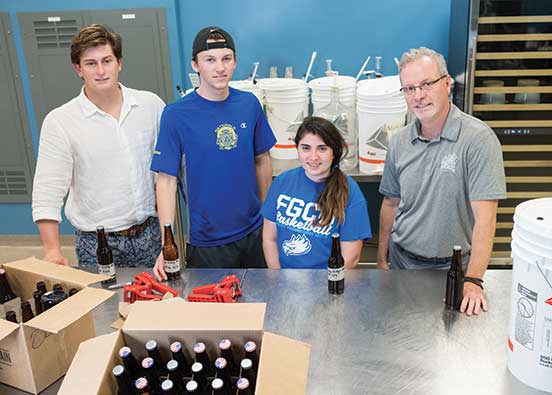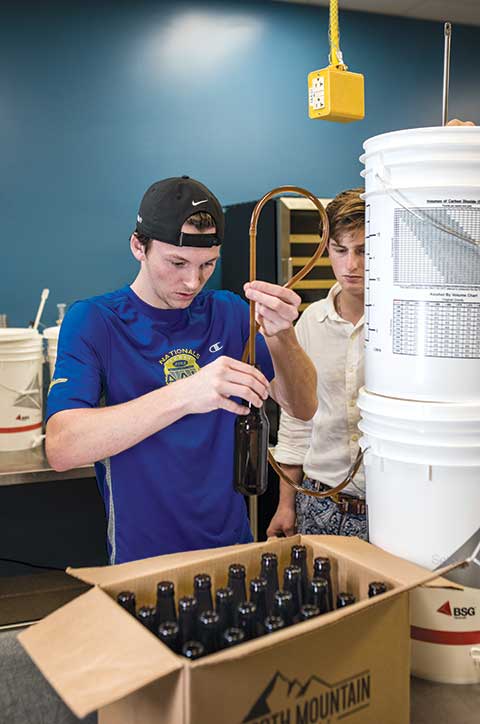Then they decided to enlist the help of students. In order to do that, they had to give them something: a research project, some pay or service-learning hours. Last fall, senior biochemistry major Thomas Strauss was awarded credits for creating a research project, “Development and Troubleshooting of a Pilot Microbrewery at FGCU,” which became a student-friendly process manual that highlighted the fundamentals and techniques for brewing eight types of beer.
By the spring semester, Reilly had brought in a consortium of students from the colleges of Arts & Sciences, Business and Engineering to refine the process in Sugden Hall’s commercial kitchen, financed with seed money from the Whitaker Center for STEM Education, the Office of Undergraduate Research and Reilly himself.
They gave two cases to President Mike Martin, the provost and deans, who sampled the beer – tagged with names like Dunk City Rocket Fuel, The Nutty Professor and, yes, even President Mike Martin Matters.
“The President tasted it and loved it,” Reilly says. “They shared it with people, who were like, ‘This is pretty good. Can we buy some?’ He said, ‘Hey, look, let’s get a brewery on campus run by students.’ ”

Now, Reilly is creating a budget of $100,000 to purchase two 20-gallon systems, but it will only happen if he is granted some of FGCU’s year-end funds. The goal is to get the proper permits and licenses, take over a spot at Azul’s Brewhouse and start selling the beer.
“We can stick with our five-gallon system, but we only get two cases at a time,” Reilly says. “Are we going to do it or not? It’s kind of a do-or-die thing now.”
On a smaller scale, you can do this at home. Here are Reilly’s beer-brewing tips:
BUY A HOME BREW KIT: Northern Brewer is Amazon’s choice for the best kit between $100 and $150. It has everything you need to brew beer at home, including recipe kit, hydrometer, test jar, thermometer, bottle brush, tubing, bottle capper and caps, five-gallon brew kettle and 6.5-gallon fermentor. Cheaper kits are available, but you will need a pot that can boil five gallons of liquid and a bucket for fermenting.

BOIL THE WORT AND COOL IT: The wort – the malt extract (from grain mash) and water – should be boiled for an hour to provide the hop alpha acid isomerization necessary for bittering, and to kill bacteria. Then cool it as quickly as possible, putting it in a sink with ice.
SANITIZE, SANITIZE, SANITIZE: Reilly has repeated this critical mantra so many times that his students have it metaphorically tattooed on their hands, which he instructs them to spray with the sanitizer bottle after touching anything. “After going through all this work, you don’t want to open up one of these buckets and see mold growing. That’s when they call it ‘skunked.’ It smells terrible. If it goes bad and you have spent two weeks on it, you will be really disappointed.”
FERMENT IT: Store it in a cool, dry place at room temperature – preferably a closet. The biggest no-no: the garage. The heat will ruin all your hard work. Follow the instructions in your kit. Fermenting times typically vary from seven to 14 days.
BOTTLE IT: A lot of the solids, the dead yeast, will be on the bottom. So siphon it out into the bottling bucket, add bottling sugar so that when you bottle it, there is secondary fermentation. That gives it the CO2, the fizz. But not a lot. Just enough so you get the taste when drinking it and it’s not flat. Buy your own bottles – a case costs about $17, and reuse them – then, yes, sanitize the bottles and caps, cap the bottles and let them sit for at least two weeks.
CHILL IT: Unless you’re British and like your beer warm.
DRINK IT: “Be honest. Is it too hoppy? Not hoppy enough? Too bitter? Is there too much or not enough alcohol? Is there enough CO2 in there? You might say, ‘Next time, I will do a little bit less sugar when bottling so that when I open it up, it doesn’t overflow because I have too much CO2.’” But save plenty of your carefully crafted creation for others. Ask family and friends to sample it and offer opinions: “Does it taste good? Most people will tell you what they like and don’t like.”[/vc_column_text][vc_column_text]
A SIX-PACK OF BEER FACTS
- The study of beer and beer-making is Greek words “zythos” (beer) and “logos” (study).
- Brewing may date back almost 5,000 years.
- The oldest operating brewing company in the U.S. is D.G. Yuengling & Son in Pottsville, Pennsylvania, since 1829.
- Cenosillicaphobia is the fear of an empty beer glass.
- Women were the first professional brewers and were called brewsters.
- The United States and China are the world’s top beer-producing countries.